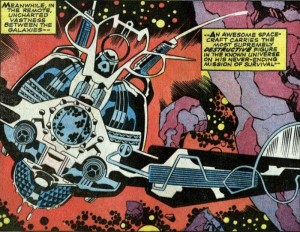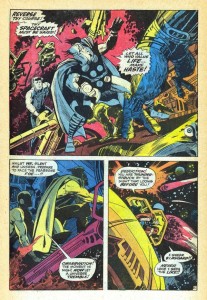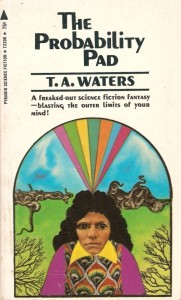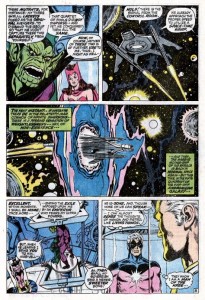
Join Brian every other Tuesday as he talks comic books from a reader’s perspective, both his new experiences with the medium and reflections on over thirty years of enjoying the finest in sequential art.

Comics get cosmic: a panel from Fantastic Four #74, May 1968, by Jack Kirby and Joe Sinnott (Image © Marvel)
I’ve made no secret of the fact I’m not a fan of “New Wave” science fiction. Don’t get me wrong, the movement’s goals were admirable and its influence laid groundwork that made many of the great science fiction books of my lifetime possible. But although the motivations were entirely legitimate, I’ve always felt that the works themselves leeched space travel, aliens, and most of the epic sense of wonder out of the genre for a good decade and a half.
However, in those years following the cancellation of Star Trek, when even the movies were following the New Wave’s lead (with films like Soylent Green, Silent Running, and The Andromeda Strain as sci-fi’s face on the big screen), there was one unlikely place you could go for big, weird stories about aliens and outer space: comic books!
(Remember how I trashed ol’ Jack “King” Kirby in my last column? Hang on to your hats, folks, I’m about to talk him up big time.)
I understand why the New Wave happened, of course. As a print medium based in aging pulp magazines and cheap paperback novels, the old tropes of square-jawed adventurers fighting their way across the moons of Venus and avuncular, pipe-smoking gentleman scientists inventing time machines in their garage laboratories were not only getting creaky in their own right, but were increasingly out of step with the tumultuous “real world” of the civil rights movement, the Vietnam War, and the growing counterculture movements of the 1960s. The readers and writers of science fiction wanted to grow up, both conceptually and commercially—they wanted stories that addressed the issues of race, sexuality, and society that concerned them and their communities on a daily basis, and works that were serious enough to rate “mainstream” book publication.
Just ’cause I get it doesn’t mean I enjoyed it, though. Aside from a few stalwart holdouts like Larry Niven and Poul Anderson, most of the sci-fi published between 1965 and 1980 just fails to fire my imagination the way works before and since that New Wave interregnum have.
But during that depressingly whizbang-free period, there was still a venue for that old-school storytelling sensibility, and that was in the four-color world of the comics.
As Marvel Comics grew in respectability and sales, editor Stan Lee and publisher Martin Goodman were able to hire new artists and lighten up the workload of the small handful of artists (Jack Kirby, Steve Ditko, Don Heck, Dick Ayers) that had produced the lion’s share of Marvel’s early work. Although Kirby had already been a comic book illustrator for 25 years when he launched Fantastic Four with Lee in 1961, once his workload was significantly reduced his art—or, more specifically, his graphic storytelling—enjoyed a real period of further development and maturation.

The larger-than-life spirit of Edmond “World Wrecker” Hamilton and E.E. Smith lives on: Thor prepares to face Galactus in The Mighty Thor #161, February 1969 (Image © Marvel)
Kirby clearly liked his stories epic, and from about 1965 or ’66 on Lee was willing to indulge him. The Fantastic Four started meeting the Inhumans and going to the Negative Zone, and once Galactus showed up the cosmic nature of their stories became the new normal. And Lee and Kirby were doing the same thing on an even crazier scale over in the pages of The Mighty Thor, where the Thunder God and his colorful cohorts from Asgard were up against monumentally mythic threats like Mangog (the embodiment of the rage of billions of people) or Ego the Living Planet (a frikkin’ planet, people!).
When things went sour between Kirby and Marvel in 1970, he took his brushes over to DC and did the same thing with his short-lived Fourth World titles (The New Gods, Mister Miracle, and The Forever People) in 1971 and ’72. Then in ’76 the King returned to Marvel to carry on that magnificent tradition with the (similarly short-lived) Eternals series.
Kirby’s post-’65 art, along with Lee’s storytelling (and later, on the 1970s works, his own writing), had a mass and solidity to it that added weight to go along with the scale. When you read Thor or Fantastic Four in the late ’60s, you came away feeling like you’d just experienced something heavy, something so colossal that your mortal brain could only grasp it dimly—not the weird, druggy inconclusiveness of Philip K. Dick or other New Wave authors, but rather allowing your imagination to fill in the blanks your conscious brain couldn’t encompass. I found that very satisfying. (Part of the great effect was the improved coloring of those late-’60s Kirby epics, a bright, full palette that often bordered on the psychedelic. Sadly, Marvel did not start crediting its colorists until 1973, so I don’t know who to praise for that very enjoyable part of these comics.)
Thankfully, Lee and Kirby didn’t keep the cosmic to themselves, either. The Avengers got in on the act when Roy Thomas put them through the now-legendary Kree-Skrull War in 1971 and ’72. Unlike the increasingly cosmic FF, or the fundamentally mythic-by-definition Asgardians, the generally down-to-earth Avengers were unlikely participants in an interstellar war, but when Captain Marvel and professional sidekick Rick Jones brought one to their doorstep, the result was the best gee-whiz-golly space adventure going at that time. (The Kree-Skrull War’s connection to its pulp antecedents got lampshaded in Avengers #96 when the Kree tyrant Ronan the Accuser makes a casual reference to a calot, which in the John Carter stories of Edgar Rice Burroughs was the Martian equivalent of a dog.)
Thomas was also the writer of the excellent, award-winning Conan the Barbarian titles Marvel started publishing in 1970, and again that link to the pulps was made explicit when Marvel launched Kull the Conqueror, Red Sonja, and John Carter: Warlord of Mars in the late ’70s.
Sadly, those last three titles were all short-lived, but the point remains valid: in the dark days of the New Wave, when science fiction gained its hard-won maturity and literary worthiness, the lost innocence of the genre’s childhood lived on for those of us who craved it (and continue to crave it to this day) in their comic counterparts.
And for that one epic, brightly-colored moment in time, Kirby truly was King.

